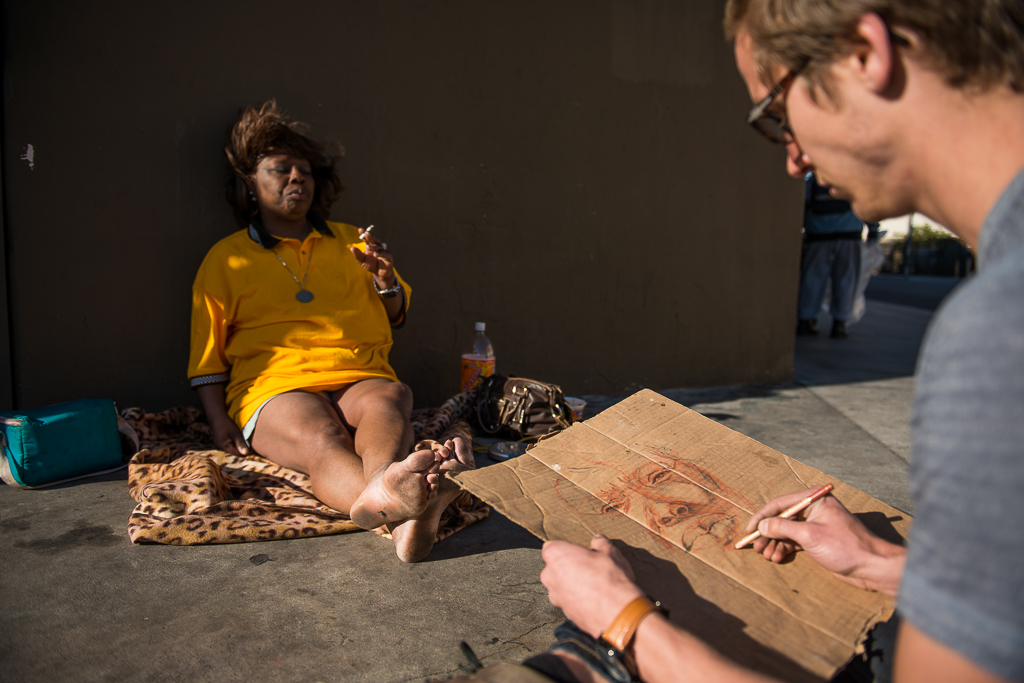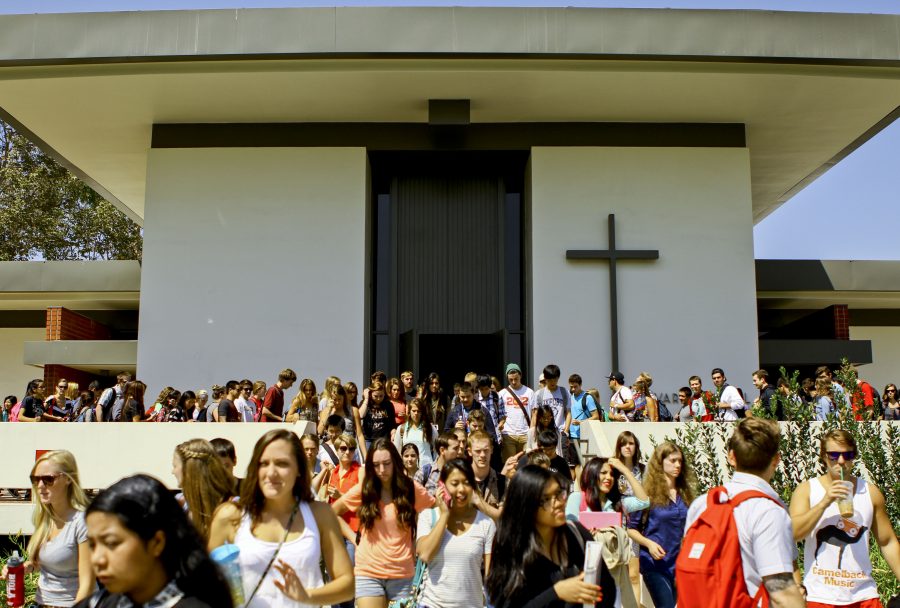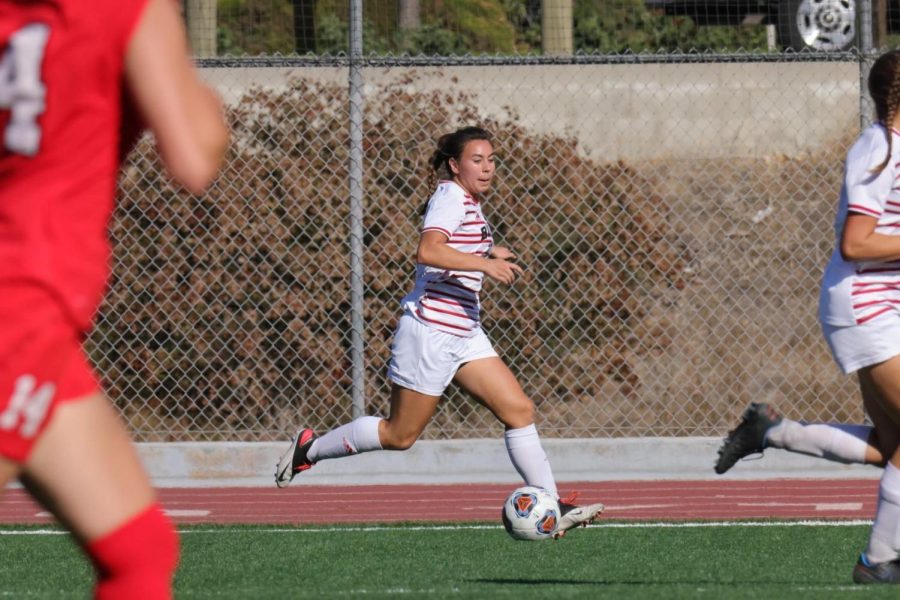
With a container of drawing tools in one hand and a portfolio of reclaimed materials in the other, senior art major Jason Leith walks the streets of Skid Row, looking to meet someone and draw their portrait. Leith has been doing this for the last few months. He will walk through the neighborhood for up to an hour — sometimes he meets someone, sometimes he doesn’t.
Each of these portraits will be a part of Leith’s senior show, Sacred Streets. His show will be held in a structure he and his team are building behind Union Rescue Mission, right in the heart of Skid Row. Leith’s desire is to bring art to a community that would not have access to it otherwise.
A FIVE YEAR PASSION NOW READY FOR ACTION
Although his idea solidified last November, Leith’s passion for this type of work began long before that. While on a mission trip in India five years ago, he began to consider ways in which he could combine art and social engagement. These ideas were furthered a year and a half ago when he drew a portrait of a man living on the streets just around the corner from Biola. After five years of mulling ideas over, Leith used his senior show as a catalyst for action.
“I’m one who thinks a lot and doesn’t do as much, and so this is finally me stopping thinking and starting to do,” Leith said.
PORTRAITS GIVE A DIGNIFIED EXPERIENCE
This time, Leith meets a woman named Roberta. She agrees to let him draw her portrait. Showing her the different materials in his possession, Leith explains that he uses reclaimed materials in order to take something that has been tossed aside and turn it into something beautiful. Roberta selects the piece of cardboard for her portrait, and Leith begins to draw.
Leith hopes these portraits will be a “vessel of calling” to men and women on Skid Row. Despite their past or present experiences, he wants them to recognize the gift that is set before them.
Roberta gets cold and asks to move across the street. Once settled into the sunlight, Leith begins to draw again and asks Roberta about her life. As she tells her story, he listens carefully and asks more questions. At one point, Roberta asks if they can take a break, and she takes a few minutes to roll a new cigarette. Leith patiently waits for her, unhurried in the time he is giving to her. The essence of Leith’s project is to draw these men and women right there on the street, face to face.

“I want to figure out how art can be a vehicle for relationship and communication,” Leith said.
Leith always wants to give beauty back to those whose portraits he draws. Sometimes, he gives them his initial sketch; other times, he finishes the portrait in his studio and brings it back to them. When he works back in his studio, his portraits constructed of reclaimed materials begin to “take on symbols of sacredness and holiness.” Even in the initial drawing, he will often have them sit in a way that emphasizes their dignity.
Through this process, Leith hopes that these men and women will feel seen, heard and loved. His desire is that they will see themselves in a new way. Leith also wants to see what it’s like to give back with non-material items, such as beauty and community.
“They get food and clothes from people all the time … I think giving them a dignified experience — they’re being turned into a piece of art, and feeling seen — can change those material situations as well,” Leith said.
CREATING ART THAT PARALLELS CHRIST'S CALL
Freshman art major Jessica Byrd, one of Leith’s five interns, sees the ways that he is exploring how portraiture can reach people both emotionally and spiritually. She sees parallels between Christ's living and walking with people to share the gospel and Leith's actions on Skid Row.
“Jason lives and walks with these people — and he draws them,” Byrd said.
Even a month out from the gallery opening, Leith is already seeing the fruit of his labor. About three weeks ago, Leith drew the portrait of a man named Robert. Having been addicted to crack cocaine for most of his life, Robert had wanted to tell his stories about the horrors of addiction.
After meeting up with Robert for two portrait sessions, Leith prayed with him, asking that the Holy Spirit would give him power to turn his life around. Just over a week later, Leith got a call from Robert. Robert had put himself into a rehabilitation program and had been clean for 72 hours. He said that he finally saw the truth in himself for the first time — all because of Leith’s portrait.
Despite learning about moments like these, Leith has never viewed this project as his own, Byrd said.
“We keep going back to — this is God’s project and he’s had it since the beginning… That’s always been [at the] forefront in Jason’s mind,” Byrd said.
Sophomore art major Hannah Efron, another one of Leith’s interns, says that Leith continues to remain humble through it all. She sees the enormous amount of effort he puts in for the glory of God.

“The time he’s putting into it — that’s sacrificial love,” Efron said.
Leith hopes that Sacred Streets will continue in a long-term capacity, in one way or another. He thinks it has the ability travel to different areas — even allowing for different artists to work with different mediums.
“Sacred Streets has a life of its own,” he said.
Back on Skid Row, Roberta starts to get tired and asks Leith if he can come back to finish. When he shows her what he has so far, she is thrilled. Leith explains to her that he will complete it in his studio and bring it back. Roberta says that she will be in the same place where they met.







